当前位置:
X-MOL 学术
›
Biol. Control
›
论文详情
Our official English website, www.x-mol.net, welcomes your feedback! (Note: you will need to create a separate account there.)
The profile change of defense pathways in phaseouls vulgaris L. by biochemical and molecular interactions of Trichoderma harzianum transformants overexpressing a chimeric chitinase
Biological Control ( IF 4.2 ) Pub Date : 2021-01-01 , DOI: 10.1016/j.biocontrol.2020.104304 Negin Eslahi , Mojegan Kowsari , Mohammad reza Zamani , Mostafa Motallebi
Biological Control ( IF 4.2 ) Pub Date : 2021-01-01 , DOI: 10.1016/j.biocontrol.2020.104304 Negin Eslahi , Mojegan Kowsari , Mohammad reza Zamani , Mostafa Motallebi

|
Abstract Trichoderma species as biocontrol agents protect plants against several pathogens via multiple mechanisms. This study was aimed to evaluate the in vitro biocontrol activities and, as well as in vivo induction of systemic resistance of Phaseolus vulgaris L. by two Trichoderma harzianum transformants overexpressing a chimeric chitinase42 with chitin binding domain (T13 and T15) and wild-type (Tw) strain with and without Rhizoctonia solani. In order to achieve this goal, T. harzianum strains were compared in vitro for their potential to antagonize activity against R. solani. Also, the expression of biocontrol-associated genes (chit42 and qid74) and the volatile compounds (VOCs) profile with biocontrol activity was analyzed from T. harzianum strains. The real-time PCR was used to measure the expression of defense-related genes involved in systemic acquired resistance (SAR) and induced systemic resistance (ISR) pathways. The results showed that recombinant strains T15 (92%) and T13 (85%) had the higher inhibitory effects against R. solani compared to the Tw strain. Also, gene expression analysis of T. harzianum revealed the up-regulation of biocontrol-associated genes in recombinant strains. Analysis of VOCs from three T. harzianum strains identified a total of twenty-two compounds, including five that were produced by all of them .VOCs analysis of recombinant strains revealed the production of compounds, like caryophyllene oxide, 2-methyl-1-butanol, α-farnesene, and β-bisabolene. These compounds had been reported to induce plant defensive reactions against stress. Inoculation of plants with T13 and specially T15 strains, restricted the R. solani growth. Treatment of bean plants with recombinant strains led to increase in protection mechanisms including enhanced defense enzymes activity and higher expression of defense-related genes, as compared with Tw. The ability of recombinant strains to have better colonization within the soil and the root surface, describes its positive effects on defense mechanisms against R. solani.
中文翻译:

过表达嵌合几丁质酶的哈茨木霉转化体的生化和分子相互作用对小菜豆防御途径的影响
摘要 作为生物防治剂的木霉属物种通过多种机制保护植物免受多种病原体的侵害。本研究旨在评估两种过表达具有几丁质结合结构域(T13 和 T15)和野生型的嵌合几丁质酶 42 的哈茨木霉转化体对菜豆的体外生物防治活性以及体内诱导系统抗性。 Tw) 带有和不带有立枯丝核菌的菌株。为了实现这一目标,在体外对哈茨木霉菌株拮抗抗茄病菌活性的潜力进行了比较。此外,还分析了哈茨木霉菌株的生物防治相关基因(chit42 和 qid74)的表达和具有生物防治活性的挥发性化合物 (VOC) 谱。实时荧光定量 PCR 用于测量参与系统性获得性抗性 (SAR) 和诱导性系统性抗性 (ISR) 途径的防御相关基因的表达。结果表明,与Tw菌株相比,重组菌株T15(92%)和T13(85%)对R. solani具有更高的抑制作用。此外,哈茨木霉的基因表达分析揭示了重组菌株中生物防治相关基因的上调。对来自三个哈茨木霉菌株的 VOC 进行分析,共鉴定出 22 种化合物,其中 5 种由所有这些化合物产生。重组菌株的 VOC 分析揭示了化合物的产生,如氧化石竹烯、2-甲基-1-丁醇、α-法呢烯和β-红没药烯。据报道,这些化合物会诱导植物对压力的防御反应。用 T13 和特别是 T15 菌株接种植物,限制了茄病菌的生长。与 Tw 相比,用重组菌株处理豆类植物导致保护机制增加,包括增强的防御酶活性和防御相关基因的更高表达。重组菌株在土壤和根表面内具有更好的定植能力,描述了其对抗病 R. solani 防御机制的积极影响。
更新日期:2021-01-01
中文翻译:

过表达嵌合几丁质酶的哈茨木霉转化体的生化和分子相互作用对小菜豆防御途径的影响
摘要 作为生物防治剂的木霉属物种通过多种机制保护植物免受多种病原体的侵害。本研究旨在评估两种过表达具有几丁质结合结构域(T13 和 T15)和野生型的嵌合几丁质酶 42 的哈茨木霉转化体对菜豆的体外生物防治活性以及体内诱导系统抗性。 Tw) 带有和不带有立枯丝核菌的菌株。为了实现这一目标,在体外对哈茨木霉菌株拮抗抗茄病菌活性的潜力进行了比较。此外,还分析了哈茨木霉菌株的生物防治相关基因(chit42 和 qid74)的表达和具有生物防治活性的挥发性化合物 (VOC) 谱。实时荧光定量 PCR 用于测量参与系统性获得性抗性 (SAR) 和诱导性系统性抗性 (ISR) 途径的防御相关基因的表达。结果表明,与Tw菌株相比,重组菌株T15(92%)和T13(85%)对R. solani具有更高的抑制作用。此外,哈茨木霉的基因表达分析揭示了重组菌株中生物防治相关基因的上调。对来自三个哈茨木霉菌株的 VOC 进行分析,共鉴定出 22 种化合物,其中 5 种由所有这些化合物产生。重组菌株的 VOC 分析揭示了化合物的产生,如氧化石竹烯、2-甲基-1-丁醇、α-法呢烯和β-红没药烯。据报道,这些化合物会诱导植物对压力的防御反应。用 T13 和特别是 T15 菌株接种植物,限制了茄病菌的生长。与 Tw 相比,用重组菌株处理豆类植物导致保护机制增加,包括增强的防御酶活性和防御相关基因的更高表达。重组菌株在土壤和根表面内具有更好的定植能力,描述了其对抗病 R. solani 防御机制的积极影响。



























 京公网安备 11010802027423号
京公网安备 11010802027423号